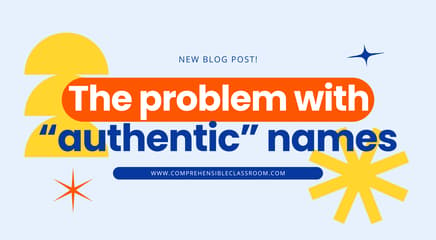MovieTalk has quickly become a favorite strategy for providing comprehensible input to language learners since Michele Whaley brought it to the TCI world in 2012. Developed by Dr. Ashley Hastings as the listening module for the Focal Skills ESL program, MovieTalk is an incredibly effective activity because it provides loads of comprehensible input to students.

I just returned from a whirlwind trip to Walter Payton College Prep in Chicago (I flew out Sunday night, arrived Monday morning, presented for 8 hours, and watched the Northern Lights dance outside the window of my plane as I flew back home Monday night!), and we squeezed in a short MovieTalk how-to session at the end of our time together. One thing that is wonderful about MovieTalk is that it is very difficult to screw up: because you are relying on the images on the screen to make what you say comprehensible and because you have something concrete to talk about, less skill is required to do a successful MovieTalk than to ask a TPRS® story. If you can push "play" and "pause" and speak in the target language, you can MovieTalk.
That being said, there are degrees of success, and as Terry Waltz has been known to say, "there are few words in the English language that have been stretched so far from their original meaning as ‘comprehensible’ in today’s foreign language teaching circles". The beautiful thing about quality TPRS® is that students understand everything--EVERYTHING--during story asking. With MovieTalk, there is still much room for misinterpretation (ex: when you point to a bee and say "bee", students could think that the word that they hear means "bee", "bug", "black", "yellow", "wings", "flying") and for total lack of comprehension (when describing an action, students might not have any idea what you are trying to say).
When we apply the essential skills and the 3 steps of TPRS® to MovieTalk, we make magic.

Step 1: Establish meaning
Before you begin the MovieTalk, consider which words (2-4) will be used often as you narrate the video, and provide translations to students for those words. Write the words in the target language on the board with English translations beside them, and establish a gesture for them. These are your "target structures", or, as Eric Herman is encouraging us to call them, your "guide words/phrases" (search the iFLT/NTPRS/CI Teaching Facebook group for "guide words" to read his rationale).
Step 2: Ask the Story
You could do some PQA or ask a TPRS® story before you do MovieTalk, or you could just do the MovieTalk for this step. MovieTalk is so simple: you just start watching a video clip, pause it and describe everything that is visible and what has happened, and then push play again. Keep pausing and describing and playing until you finish the video clip that you are working with. It's so easy!
When you apply your TPRS® skills to MovieTalk, you will access most of the benefits that go along with story asking. Here are three key skills that we should strive to master in order to provide MovieTalk input that is truly comprehensible and compelling to our students:
- Circling
- Personalization (asking questions that connect students to the story)
- Checking for comprehension
Of course, there are many other essential skills needed to make input truly comprehensible for all students in your class (going slow, point and pause, etc.), but mastery of these three is a great starting point to maximize the potential of MovieTalk.
Step 3: Read and discuss
After you have finished pausing and playing and describing the video, you have technically finished a MovieTalk activity. Now, you can extend it--and what better way than with reading?!
“People acquiring a second language have the best chance for success through reading” (Stephen Krashen, The Power of Reading (1993, p.4)), and so we READ with our students. We read often. We read together. They read individually. They read with partners. I read to them. We read, read, READ!
After I have finished asking a TPRS® story with my class or have finished a MovieTalk, I like to read the story in its entirety with my students. The best way to do this is to project the story and read through it together. This allows me to further circle guide words (target structures) that students have not yet acquired, personalize the content even more, and--most importantly--get a deep, accurate read on my students' comprehension of the story. Typically, 'reading it together' looks like either me reading it aloud or the students reading it aloud with me, chorally, and stopping frequently to ask circling, personalization, and comprehension questions about what we just read. I don't prefer to translate the text word for word, although it is true that asking for translation of a text is the best way to know what students know and don't know. There is no way to hide a lack of comprehension when a student is asked to translate. When I do have students translate the text word for word, students say the word in English as I point to it in Spanish. I point to the words out-of-order in Spanish so that they make sense in English (ex: "la chica pobre" I point to la - pobre - chica so that students say "the poor girl" aloud). I do whole-text, word-for-word translations mostly in the beginning of Spanish 1. Once I know that I know that I know that all my students have acquired a word or set of words, I don't need to have them translate those words in order for me to know for sure that they understood them. I know that they understood them because previous assessments (formative and summative) have proven that to me. As the year wares on, I have students translate select sentences from texts that contain new words that I am not yet confident have been acquired.
Oh goodness, I've gotten off track.
Reading a story in its entirety is especially important if you want to continue to work with it in class--and if you've gone through all the trouble to do a TPRS® story or a MovieTalk lesson, why wouldn't you work with it some more?! This will help students to remember details from the story and to get another set of repetitions of the words in the story. If you can't project it and read it together, then give students a copy of the story and have them follow along. But seriously, if you don't have projection capabilities, get yourself over to DonorsChoose.org and set up a request for a projector! It is so helpful for TCI (Teaching with Comprehensible Input).
After we have read through the text together once in its entirety, we begin activities. You can do the same activities post-MovieTalk as you do post-TPRS®: something like Running Dictations, Two Truths and a Lie, Who said it?, or Illustrating a class storybook. There are an infinite number of activities, and you can read about 80+ ideas here.
In my MovieTalk workshop, I work through a lesson with the short film "Wildebeest" by Birdbox Studio. This is the first MovieTalk that I do with my Spanish students; I use it in the first week of Spanish 1. To flush out the lesson and really milk it for all it's worth, I use Embedded Reading (developed by Michele Whaley and Laurie Clarcq) to read through four levels of the original story, each more detailed than the last.
The first level reading is VERY basic; super simplified from the MovieTalk script that I worked from (which you can access here).

Click on the image to download the slideshow
With my Spanish 1 students in the first week of school, this very simple version of the story is PERFECT for a Blind Re-tell, and so that is the first story activity that we use with this short film. (*You might choose to have students read the story in the past tense, and so in my PPT file I included past tense readings as well.)
Then, we read through a more detailed version of the same story. Remember--MovieTalk is done, so at this point we are not watching the video again, we are just working with the story from the video.

Click on image to access slideshow
This time, I opt for a Pencil Grab activity, which I learned from Carmen Andrews-Sanchez via Kristin Duncan's blog. It's so simple and so fun! I say a series of statements from the reading (some true and some false), and students try to grab a pencil before their partner does anytime that they hear a true statement. Instead of saying statements randomly from all over the text, I prefer to work through the text methodically so that students end up reading straight through the story another time. For example:
- "Hay tres ñus" (false)
- "Hay dos ñus" (true)
- "Un ñu es un antílope de Antártica" (false)
- "Un ñu es un elefante de África" (false)
- "Un ñu es un antílope de África" (true)
- "Hay un objeto" (true)
- "Hay un objeto pequeño" (false)
Students get a point anytime that they beat their partner to a pencil when a true statement is read, and they lose a point if they grab the pencil when a false statement is read. Be very clear when you explain to students that the statements should be assessed as true or false based on what the text says, not based on any outside knowledge or opinions that they might have. Work through the entire story with the Pencil Grab activity!
Time for another read-through..bring on Embedded Reading Level 3!
This reading is more detailed and can't fit on a single slide, so after we read it together, I choose a story activity that doesn't require students to be able to see the text: I choose a listening activity. And what better listening activity to start of the year with a bang than Strip BINGO? I have students fill out a strip of 7 words from the word cloud below (click here to read about ways to use word clouds in CI classes), and then I read through the story 1+ times until we have a winner (always at least finish one read-through, even if someone wins before you finish reading).

Hey, we're on a roll--let's go for four! Four levels of Embedded Readings whaaaaaaat?! Yes! Why not?! It's a fun story and it is simple, even when you add three extra layers of details.

For my last activity, I chose Write, Draw, Pass because it's awesome, it's easy, it's super fun, and it provides me with tons of cool illustrations and papers that I can use to continue talking about this video if I want to.
And there you have it!! Isn't it incredible how much you can do with a single piece of content?? MovieTalk really is a wonderful and effective activity in and of itself, but I love how powerful it becomes when we apply the steps and skills of TPRS® to it!! Download the complete slideshow with four levels of Embedded Readings here! (It's free!)









